what to do if your cat has ticks
Although ticks are commonly thought of as insects, they are actually arachnids similar to scorpions, spiders, and mites. All developed ticks have eight legs and have no antennae. Adult insects by comparison have vi legs and one pair of antennae. Ticks are parasites that feed on the blood of their host, which can be an animal or a human.
"Because cats are captious groomers, numerous ticks could exist a signs of illness."
Ticks are efficient carriers of illness because they attach firmly when sucking claret, feed slowly and may go unnoticed for a considerable time while feeding. Ticks take several days to complete feeding.
Considering cats are fastidious groomers, it is rare to encounter more than than ane or two ticks on a cat. If you detect numerous ticks, this could be a sign of disease in your cat (cats that are ill usually exercise non groom themselves).
What are the dissimilar types of ticks?
There are ii groups of ticks, sometimes chosen difficult ticks and soft ticks. Hard ticks, like the common canis familiaris tick, have a difficult shield just backside the mouth parts (sometimes incorrectly called the head); unfed hard ticks are shaped like a flat seed. Soft ticks practice not accept the hard shield and they are shaped like a raisin. Soft ticks prefer to feed on birds or bats, and are seldom found on dogs or cats.
What is the tick's life cycle?
Ticks have four distinct life stages:
ane. Egg
2. 6-legged larva
3. Eight-legged nymph
4. Developed
Females deposit from iii,000 to half dozen,000 eggs on the ground. Adult ticks seek host animals, and after engorgement on blood, mate.
Male difficult ticks unremarkably die after mating with one or more females, although some may alive for several months. Females die soon after laying their eggs in protected habitats on the footing. The life cycle requires from as piddling as two months to more than two years, depending on the species.
After the egg hatches, the tiny larva (sometimes chosen a seed tick) feeds on an appropriate host. The larva so develops (molts) into the larger nymph. The nymph feeds on a host and then molts into an even larger developed. Male and female adults feed and mate on the host; the female person falls to the footing to lay her eggs, continuing the life cycle.
How did my cat get ticks?
Ticks await for host animals on the tips of grasses and shrubs. When the plant is brushed by a moving animate being or person, they quickly let go of the vegetation and climb onto the host. This is a process known as questing. Ticks tin can only clamber; they cannot fly or jump. Some species of ticks will crawl several feet toward a host. Some tick species tin can be agile on winter days when the ground temperatures are about 32°F (0°C).
Are there certain ticks that I should be concerned near? 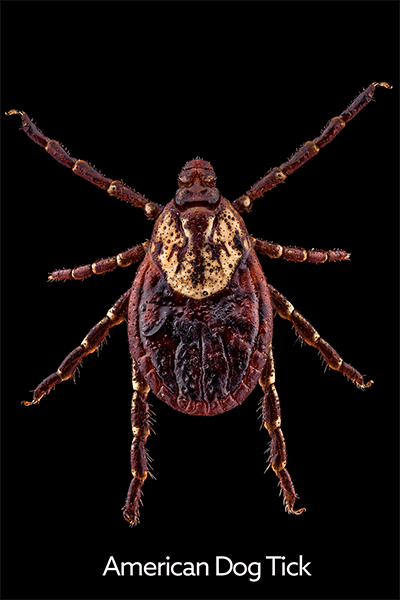
Although there are at least 15 species of ticks in Northward America, only a few of these species are likely to be encountered by your cat. They include American domestic dog tick, lone star tick, deer or black-legged tick, and brown domestic dog tick.
Other tick species may be encountered in various regions. Ask your veterinarian if you need additional information well-nigh a specific species.
American Dog Tick
The American domestic dog tick feeds on a broad variety of hosts, including humans, dogs, and occasionally cats, but rarely infests homes. Adults are anecdote brownish with white spots or streaks on their backs.
Engorged females become slate gray and may expand to a length of 1/2" (x-12 mm). Larvae and nymphs feed mostly on modest rodents, while adults feed on dogs, cattle, other animals, and humans. These ticks are widely distributed throughout the Midwest, Pacific Northwest, and eastern United States, likewise as e of Saskatchewan in Canada. They are attracted by the scent of animals, and humans almost oftentimes encounter them near roads, paths, trails, and recreational areas. Although present all twelvemonth round, American canis familiaris ticks are nigh numerous in the bound.
The female dog tick lays iv,000-6,500 eggs and then dies. The unfed larvae crawl in search of a host and tin can live up to 540 days without nutrient. Nymphs can live without food for up to 584 days. That's over a year-and-a-one-half!
Adults crawl in search of dogs or big animals for a claret meal. Adults can live for upwards to two years without food. American domestic dog tick adults can be found in a waiting position on grass or other low vegetation forth roads, paths, and trails. Every bit an animal passes by, the tick will crawl onto it and soon beginning feeding. The males remain on the host for an indefinite menses of time alternately feeding and mating. The females feed, mate, become engorged, so drop off the animal to lay their eggs.
"Adult American dog ticks can live for upward to ii years without food."
The American dog tick requires from three months to 3 years to consummate a life cycle. It typically is dependent on climatic and environmental weather condition for its eggs to hatch.
Lone Star Tick 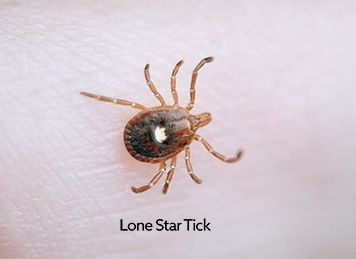
Adult lone star ticks are various shades of brown or tan. Females accept single silvery-white spots on their backs and males have scattered white spots. After feeding, females may exist 1/ii" (10-12 mm) long. Larvae and nymphs parasitize modest wild fauna, birds, and rodents, while adults feed on larger animals such as dogs and cattle. All 3 stages of the lone star tick will bite dogs and humans and occasionally can be plant on cats.
"Lonely star tick live in wooded and brushy areas."
These ticks live in wooded and brushy areas and are most numerous in the underbrush along creeks and river bottoms and nigh animal resting places. Lone star ticks are present throughout the year, but peak populations may occur from March to July. Regionally, they can be establish in the Midwest, eastern, and southeastern The states. The range of the lonely star tick may be expanding with the re-introduction and increased populations of white-tailed deer in many areas of the eastern US.
Deer or Blacklegged Tick 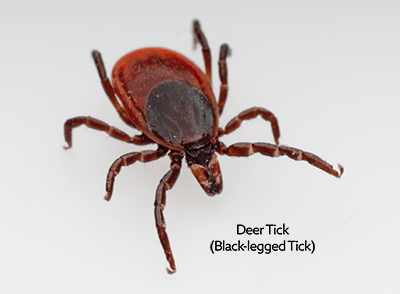
All three agile stages of the deer or black-legged tick will feed on a variety of hosts including cats. After the eggs hatch in the jump, the very tiny larvae feed primarily on white-footed mice or other minor mammals. The following bound, the larvae molt into pinhead-sized, brownish nymphs that will feed on mice, larger warm-blooded animals, and people. In the fall, they molt into adults that feed primarily on deer, with the females laying up to 2,000 eggs the following spring.
Adults are reddish-brown and have a dark brown or black shield-similar shape betwixt their oral fissure parts and body.
"Fortunately, Lyme disease is extremely unlikely to occur in cats and as of 2018 has not been seen outside of a controlled laboratory setting."
These ticks are usually found in wooded areas along trails. They are distributed through the midwest and eastern United States, every bit well as throughout Canada with the highest proportion in eastern Canada. The larvae and nymphs are agile in the leap and early summer; adults may be active in both the bound and fall. The deer or black-legged tick tin transmit Lyme affliction and mayhap ehrlichiosis and anaplasmosis to dogs and humans. Powassan virus tin can also be transmitted past the blackness-legged tick to people. Fortunately, Lyme disease is extremely unlikely to occur in cats and as of 2018 has not been seen exterior of a controlled laboratory setting.
Dark-brown Domestic dog Tick 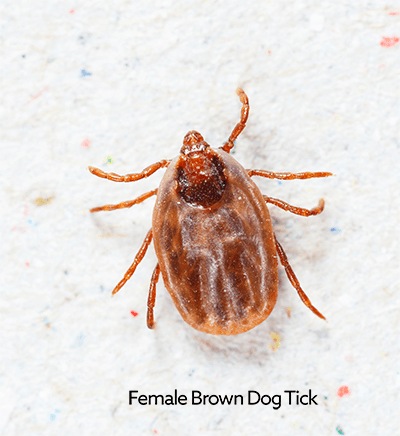
The chocolate-brown canis familiaris tick (also known as the kennel tick) is found through about of the United States and Canada. This tick feeds on dogs, but rarely bites people or cats. Dissimilar the other species of ticks, its life bicycle allows it to survive and develop indoors which means it can establish itself in colder climates. The brown domestic dog tick is found primarily in kennels or homes with dogs, where it may be plant hiding in cracks, behind radiators, under rugs and furniture, and on draperies and walls.
"This tick is tropical in origin and does not survive long, cold winters outdoors."
The adult is ruby-red-brown and usually attaches around the ears or between the toes of a dog to feed. After feeding, a female may engorge to 1/two" (x-12 mm) long. She then drops off the canis familiaris and crawls into a hiding place where she may lay as many as 5,000 eggs. This tick is tropical in origin and does not survive long, common cold winters outdoors.
Longhorned Tick 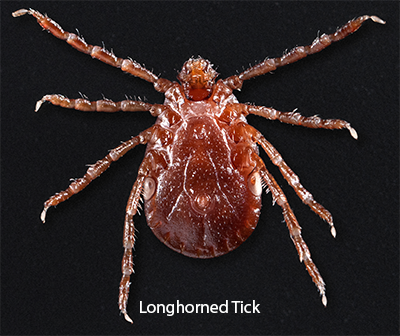
The longhorned tick was showtime detected in 2017 in New Jersey, and as of August 2019, these ticks take been found in 11 other The states states (Arkansas, Connecticut, Delaware, Kentucky, Maryland, Northward Carolina, New York, Pennsylvania, Tennessee, Virginia, and West Virginia). These ticks take been found on cats, dogs, livestock, and people. While it is not entirely clear if these ticks conduct bacteria and viruses that could cause illness in North America, in other countries, longhorned ticks transmit severe fever and thrombocytopenia syndrome virus (SFTSV) to people. These ticks are unique in that the female tick reproduces and lays eggs without mating.
What can I do to prevent my cat from getting ticks?
There are many tick preventatives available commercially. They range from over the counter products such as powders and collars that have limited effectiveness, to stronger products that are only available through your veterinarian. Some products, especially powders, require frequent applications, while others require minimal effort on the part of the true cat owner. One of the most user-friendly and constructive products is a flea and tick preventive called Bravecto® that is just practical topically, to the skin on back of the cervix where it is absorbed.
It is important to NEVER employ flea and tick products meant for your dog on your true cat as they can be toxic, causing your cat to have seizures. Your veterinary volition make specific recommendations to keep your cat parasite gratis.
What should I do if I find a tick on my cat?
Apply fine tipped tweezers or disposable gloves to handle the tick. If you must use your fingers, shield them with a tissue or paper towel.
"Infectious agents may exist contracted through mucous membranes or breaks in the peel only by handling infected ticks."
Infectious agents may exist contracted through mucous membranes or breaks in the pare just past handling infected ticks. This is especially important for people who de-tick pets considering ticks infesting dogs and other domestic animals can comport multiple diseases capable of infecting humans.
Grasp the tick as close to the skin surface as possible. This reduces the possibility of the caput detaching from the body upon removal. 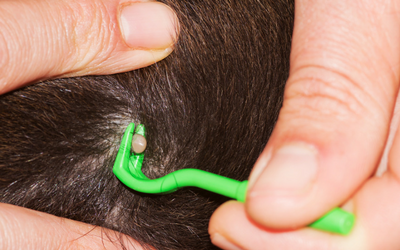
Pull the tick out straight out with steady, even pressure. Continue applying steady force per unit area even if the tick does not release immediately. It may have a minute or ii of constant, irksome pulling to cause the tick to release. There are also tools bachelor called Tick Twister® or Tick Key® which can be useful. Nevertheless, have care to employ them charily as twisting or jerking the tick may crusade the oral fissure parts to interruption off and remain in the peel, increasing the chances of infection.
After removing the tick, thoroughly disinfect the bite expanse and wash your hands with soap and water. Home remedies such as applying petroleum jelly or grease, or touching the rear of the tick with a hot match practise not piece of work effectively, and are not recommended. These techniques cause the tick to salivate and can actually increment the gamble of your pet getting a illness.
"Home remedies, such as applying petroleum jelly, volition cause the tick to salivate and tin actually increase the chance of your pet getting a illness."
Later removing the tick, you may wish to preserve it in rubbing booze for identification. Be sure to characterization the container with information about the fourth dimension and place where the tick bite occurred. This volition help you lot to remember details of the incident, especially if a rash or other symptoms associated with Lyme disease appear later on. This data will be of assist to a veterinarian or physician diagnosing an illness.
Source: https://vcahospitals.com/know-your-pet/ticks-in-cats
0 Response to "what to do if your cat has ticks"
Post a Comment